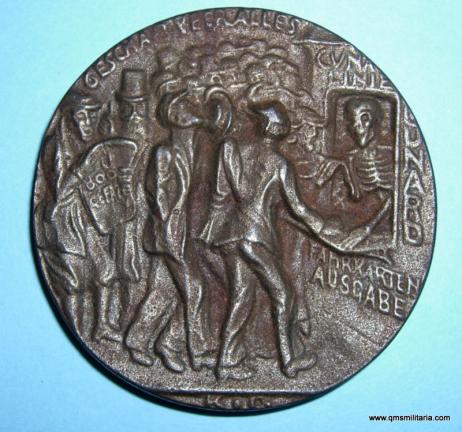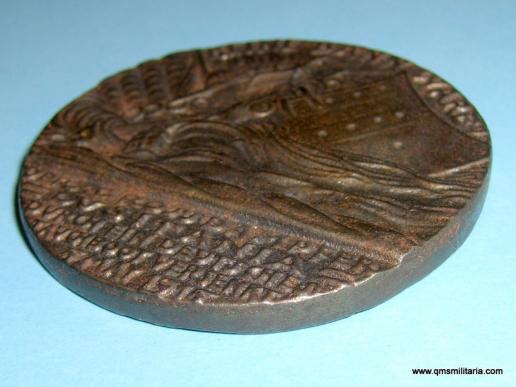British Copy of the German 1915 Sinking of the Lusitania Iron Medal
This iron medallion measures circa 55 mm in diameter and is circa 3mm thick. Regrettably it is missing its box.
It is one of some 300,000 British copies made on the instructions of Captain Reginald Hall, RN, Director of Naval Intelligence as an item of anti-German propaganda. The original German medallion was made in August 1915 by Karl Goetz, a Munich based medallist, to mock British claims that the liner was not carrying armaments. But he made a huge mistake in getting the date of the sinking wrong, and this handed a propaganda victory to the Allies.
The medallion is packed with iconography. The obverse
depicts the stricken liner sinking, her stern submerged to the left while her bow, laden with armaments, rises clear of the water (this an image contradicting eye-witness accounts which stated that the ship went down bow first). The bow is depicted as being ram-shaped, a reference to the configuration of warships of the period and possibly a reminder that the British Admiralty had ordered merchant vessels to attempt to ram German submarines. The obverse text 'KEINE BANN WARE!', around the upper edge, is translated as 'No Contraband Goods'. The text in five lines in the obverse exergue:
'DER GROSS-DAMPFER=LUSITANIA=DURCH EIN DEUTSCHES TAUCHBOOT VERSENKT 5.MAI 1915'
translates as 'The Liner Lusitania sunk by a German submarine 5 May 1915'.
The liner of course was sunk on the 7th May. The use of the '5 May' was taken from the German original, the first batch of which mistakenly carried the date 5 Mai (5th May); later German versions where corrected to 7 Mai.
The date error was used by British Intelligence to imply 'advanced planning' and that the fate of the Lusitania was sealed before her departure from New York, her sinking being premeditated and pre-arranged - although obviously some unspecified circumstance had prevented its accomplishment on the ordained date.
The reverse design shows 'Death', in the form of a skeleton, behind the ticket office counter of the Cunard Line in New York, issuing tickets to a crush of passengers. Above the window are the words 'CUNA LINIE'. Arranged vertically down the right side of the window is the word 'CUNARD' and below the counter 'FAHRKARTEN AUSGABE' ('ticket-office'). At the extreme left of the crowd a man reads a newspaper bearing the headline 'U BOOT GEFAHR' ( 'U-boat danger') and standing next to him is a top-hatted and bearded figure, a representation of the German Ambassador to the USA, Count Johann-Heinrich von Bernstorff, raising a warning finger. The significance of this reference is that on 1 May 1915, Lusitania's sailing day from New York, a German-sponsored announcement appeared next to the Cunard advertisement in all New York papers reminding passengers that Germany was at war with Britain and her allies and that the war zone included the waters around the British Isles, also that vessels flying the flag of Great Britain, or any of her allies, were liable to destruction in British waters. The reverse text 'GESCHÄFT ÜBER ALLES', upper edge, is translated as 'Business above all'. The initials of the designer, 'KG', are to be found in the reverse exergue.
The centenary of this tragic event is fast approaching.
Sold to E B
Code: 54242



